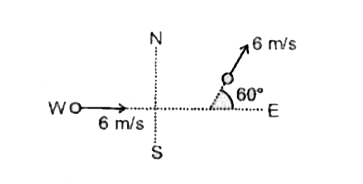The distance between two particles is decreasing at the rate of 6 m/sec. If these particles travel with same speeds and in the same direction, then the separation increase at the rate of 4 m/sec. The particles have speed as
5 m/sec, 1 m/sec
4 m/sec, 1 m/sec
4 m/sec, 2 m/sec
5 m/sec, 2 m/sec
The correct Answer is:A
To solve the problem, we need to analyze the information given about the two particles and their speeds. Let's break it down step by step.
Step 1: Understand the problem
We have two particles moving towards each other, and the distance between them is decreasing at a rate of 6 m/s. When they are moving in the same direction, the distance between them increases at a rate of 4 m/s.
Step 2: Set up the equations
1. When the particles are moving towards each other:
- Let the speeds of the two particles be v1 and v2.
- The rate at which the distance decreases is given by:
v1+v2=6(1)
2. When the particles are moving in the same direction:
- The rate at which the distance increases is given by:
v1−v2=4(2)
Step 3: Solve the equations
Now we have a system of two equations:
1. v1+v2=6
2. v1−v2=4
We can solve these equations simultaneously.
Step 4: Add the equations
Adding equations (1) and (2):
(v1+v2)+(v1−v2)=6+4
This simplifies to:
2v1=10
So,
v1=5m/s
Step 5: Substitute to find v2
Now substitute v1=5 into equation (1):
5+v2=6
This gives:
v2=1m/s
Conclusion
The speeds of the two particles are:
- v1=5m/s
- v2=1m/s
Final Answer
The particles have speeds of 5 m/s and 1 m/s.
---
We have two particles moving towards each other, and the distance between them is decreasing at a rate of 6 m/s. When they are moving in the same direction, the distance between them increases at a rate of 4 m/s.
1. When the particles are moving towards each other:
- Let the speeds of the two particles be v1 and v2.
- The rate at which the distance decreases is given by:
v1+v2=6(1)
- The rate at which the distance increases is given by:
v1−v2=4(2)
Now we have a system of two equations:
1. v1+v2=6
2. v1−v2=4
Adding equations (1) and (2):
(v1+v2)+(v1−v2)=6+4
This simplifies to:
2v1=10
So,
v1=5m/s
Now substitute v1=5 into equation (1):
5+v2=6
This gives:
v2=1m/s
The speeds of the two particles are:
- v1=5m/s
- v2=1m/s
The particles have speeds of 5 m/s and 1 m/s.
Similar Questions
If a paritcle travels distance S2 and s-2withspeeds v_1and vec _2 in the same direction, then average speed of the particle is …………………………………. .
View SolutionTwo particles of equal mass are moving along the same line with the same speed in the same direction. What is the speed of the centre of mass of the system ?
View Solution
Knowledge Check
The distance between two trucks moving towards each other is decreasing at the rate of 10m/s. If these trucks travel with same speeds in same direction the separation increases at the rate of 5m/s. The speeds of the trucks are :
AV1=8.5m/s,V2=1.5m/sBV1=7.5m/s,V2=2.5m/sCV1=5m/s,V2=5m/sDNone of theseTwo cars move uniformly towards each othar, the distance between them decreases at the rate 50 m/s. If they move in same direction with different speeds, the distance between them increases at the rate 10 m/s. The speed of two cars will be
A30 m/s and 20 m/sB40 m/s and 10 m/sC15 m/s and 35 m/sD25 m/s and 25 m/sA speed of 55m/sec is the same as
A198 km/hrB11km/hrC155/18 km/hrD275 km/hr
A train 180m long moving at the speed of 20m/sec over -takes a man moving at a speed of 10m/sec in the same direction. The train passes the man in
View SolutionA speed of 22.5 m/sec is the same as
View SolutionA train 180 m long moving at the speed of 20 m/sec.Over-takes a man moving at a speed of 10m/sec in the same direction .The traiin passes the man in:
View SolutionTwo particles P and Q describe simple harmonic motions of same period , same amplitude along the same line about the same equilibrium position O. When P and Q are on opposite sides of O at the same distance from O they have the same speed of 1.2m/s in the same direction, when their displacements are the same they have the same speed of 1.6m/s in opposite directions .The maximum velocity in m/s of either particle is
View SolutionA particle is moving eastwards with a speed of 6 m/s. After 6 s, the particle is found to be moving with same speed in a direction 60∘ north of east. The magnitude of average acceleration in this interval of time is

View Solution